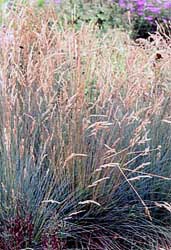Grasslands Management for Environmental Improvement

Grasslands are Very Important
In the past there was not a great deal of interest in native grasslands. However it is now recognised that grasslands, like all other types of ecosystems, are very important resources both from a landscape and biodiversity perspective. They contribute to the environment in so many ways:
- buffering temperature - a treeless area covered by grass will be warmer on cold nights and cooler on hot days than bare earth or pavement.
- reducing the impact of rainfall - grass cover catches a certain amount of water, and slows it's flow across the ground; thus reducing soil loss through erosion
- improving soil structure and nutrition - roots penetrate the soil, then die and add organic matter. They hold soil together. Dying plant parts feed microorganisms in the soil. Soil gradually improves in structure and fertility if grassland is allowed to exist, but when overgrazed or cleared, the soil quality can deteriorate
- biodiversity is supported - grassland is a natural habitat for many animals from mammals and birds to tiny insects and worms. grassland also protects and supports a diversity of plantlife. All living things are interrelated, and disturbing the grassland ecosystem can disrupt biodiversity and have many unforeseen impacts.
The value of grassland areas is not only in the grass species. There are many other plants, particularly herbs and wildflowers that occur naturally in grasslands. To lose the grasslands would also pose a serious threat to the gene pools of many of these plants; some (if not many), having a great economic potential.
Plants from grasslands provide the following benefits:
- Raw material for pharmaceuticals and other chemicals
- Horticulturally valuable ornamental plants (eg. cut flowers)
- Material for breeding agricultural crops; for example, a plant from native grassland may be used to breed disease resistance into an important crop. This has already happened.
- Essential food/environment for unique species of wildlife (to lose the flora may in turn result in the loss of fauna).
Strategies to Preserve and Manage Grasslands
Sensitive Management
The aim of Sensitive Management is to maintain and maximise populations of component species. This option really only works if the site is still dominated by native grasses; or at least NOT dominated by vigorous introduced grass species.
Grazing of native grasslands (by sheep and cattle) can destroy natural ecosystems. In some instances however, controlled grazing may occur in relative harmony with the natural ecology. Sensitive management may involve determining what stocking rates are tolerable, and not exceeding those rates.
Repeated burning, slashing or cultivation can reduce native plant populations in native grassland over time. Though these might be standard land management practices on some sites, they should not be undertaken on native grasslands unless the full implications of the procedure are first understood.
These actions are more likely to be a problem in native grasslands which are contaminated with weed species. The changes in the soil conditions will often create conditions less conducive to native species, and more conducive to weed species. The net result can be that weeds develop a dominance.
In situations where taller exotic grasses are becoming dominant (e.g. Agrostis or Rye Grass), appropriate management may be to mow the grasses low (eg. 5-10cm), to weaken them, and allow resilient native herbs to compete with the grasses.
Reintroduction
The aim of Reintroduction is to reintroduce native species which have disappeared into either exotic or native dominated grasslands. This may be done by:
- Surface Sowing: The area is first mown low, or burnt (his increases the chances of broadcast seed reaching the soil, and remaining moist while germinating). The result of this procedure has in the past often been poor. It can work though, and light mulching after sowing seed may increase results.
- Slit Seeding: This involves planting seed of native species into the soil in slits or rows; either by hand, or using a seed drill (i.e. seed sowing machine as used by farmers).
- Planting Seedlings: Seedlings are raised in a nursery, and then planted out. Timing is critical, and is planned according to seasonal rainfall patterns.
Re-creation
Recreate native grassland from a changed, destroyed or degraded site.
In the absence of weed competition, it is much easier to re-establish native species. Weed control therefore in critical. Timing is particularly critical if seeding into the field (i.e. on the permanent site). You must also know and consider the germination requirements of any plants which are seeded (grasses, herbs, wildflowers etc). Some may require particular light, temperature or moisture conditions to germinate.
How to Better Manage grassland starts with Education and a raised Awareness.
Learn to identify the differences between different grassland species
Learn to understand the complex interrelationships that exist in different savannah ecosystems
You may also be interested in....